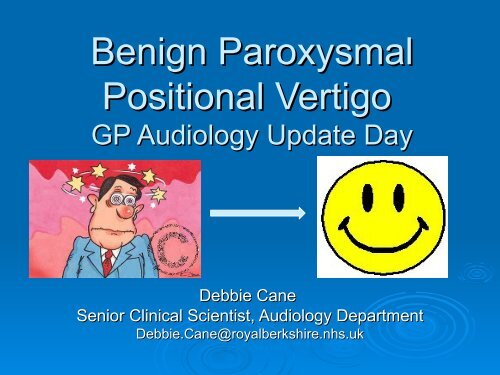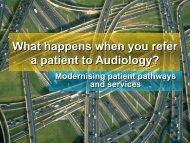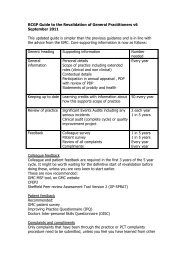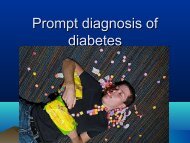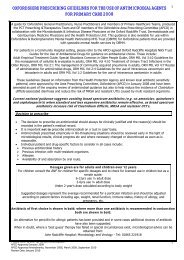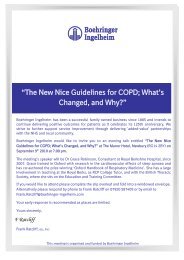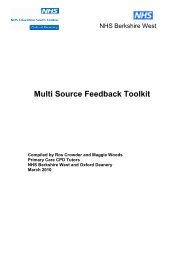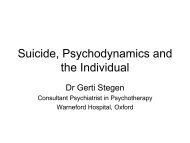Benign Paroxysmal Positional Vertigo
Benign Paroxysmal Positional Vertigo
Benign Paroxysmal Positional Vertigo
You also want an ePaper? Increase the reach of your titles
YUMPU automatically turns print PDFs into web optimized ePapers that Google loves.
<strong>Benign</strong> <strong>Paroxysmal</strong><br />
<strong>Positional</strong> <strong>Vertigo</strong><br />
GP Audiology Update Day<br />
Debbie Cane<br />
Senior Clinical Scientist, Audiology Department<br />
Debbie.Cane@royalberkshire.nhs.uk
BPPV: Overview<br />
Incidence and<br />
symptoms<br />
Testing<br />
Treatment<br />
Practical<br />
Electron microscope of otoconia<br />
David Lim
BPPV<br />
Caused by otoconia<br />
present within the<br />
semicircular canals<br />
Most common balance<br />
organ problem<br />
(20-40%)<br />
Increases in incidence<br />
with age
Presentation<br />
Sudden, intense vertigo and nausea<br />
Duration: 5-40 seconds<br />
After brief latency (usually)<br />
On head movements wrt gravity<br />
<br />
<br />
<br />
<br />
Lying down/getting out of bed<br />
Rolling in bed<br />
Looking up<br />
Bending down
Comparison with other Balance Organ<br />
Disorders
Causes<br />
<br />
<br />
<br />
<br />
BPPV<br />
49% Idiopathic<br />
18% Trauma<br />
18% with Menieres/VBI/MS<br />
15% with Vestibular neuritis<br />
Types<br />
• Canalithiasis (most)<br />
• Cupuloithasis<br />
Canal affected<br />
<br />
Posterior: 94%<br />
<br />
Horizontal: ~3-12%<br />
<br />
Anterior: ~2%
What would be your Ideal Test<br />
Quick<br />
Cheap<br />
Easy<br />
Test results immediate
Testing for BPPV<br />
What you need<br />
<br />
<br />
<br />
One couch (should already have)<br />
One confident GP (you after today!)<br />
One compliant patient (not always so easy)<br />
Total test time: 4 minutes<br />
<br />
<br />
2 minutes: to ensure no contraindications and show<br />
patients manoeuvre, help patient on couch<br />
1 minute per side for test<br />
Test result immediate<br />
<br />
If +ve refer to audiology, seen within 2-6 weeks,<br />
symptom free patient (in most) after this session
Dix Hallpike<br />
http://emcrit.org
Dix Hallpike-Barker BPPV CD rom
Right Dix Hallpike<br />
1. Sat upright with right torsion 45°<br />
2. Right head hanging position<br />
Furman, JM & Cass, SP, 1999
Absolute Contra Indications for Dix<br />
Hallpike: Humphriss 2003<br />
Severe cervical spine or lower back problems,<br />
injury or surgery eg RA, fracture, whiplash (see footnote)<br />
Carotid sinus syncope<br />
VBI proven and verified<br />
Vascular dissection syndrome<br />
Arnold Chiari malformation<br />
Footnote: Cervical spine instability including atlanto-axial subluxation, occipitoatlantal<br />
instability, prolapsed disc with radiculopathy, cervical myelopathy, , acute trauma to<br />
neck ‘whiplash’ restricting torsional movement, previous cervical spine surgery, recent<br />
fracture of cervical spine or fracture of odontoid peg aplasia of odontoid process,<br />
severe rheumatoid arthritis affecting neck
Functional Neck Mobility<br />
Assessment: Humphriss<br />
If patient can sit for 30 s without pain or<br />
discomfort with<br />
<br />
Neck torsion 45°: : side lying test √<br />
<br />
Neck torsion + extension: Dix Hallpike √<br />
Humphriss 2003
Other Points<br />
Instructions important, show the patient<br />
Observe eyes for positional nystagmus<br />
Start with least suspect ear<br />
Ask the patient to lie down<br />
Support patients head and neck from<br />
behind sat on chair to protect your back
Other Points (2)<br />
Hold position for 30-45 seconds<br />
Quickly down and slowly up<br />
Check for habituation- a repeat<br />
manoeuvre should give a lesser response
Modifications for the Elderly<br />
Possible in most<br />
Ensure no contraindications<br />
<br />
eg carotid sinus syncope, VBI, severe neck problems<br />
Ensure patient safety and use 2 clinicians<br />
<br />
<br />
<br />
Dix Hallpike-do testing slowly (to avoid postural<br />
hypotension)<br />
Modified supported DH with patients head flat on<br />
couch (Angeli et al RCT > 70 years)<br />
Sidelying test
Positive Dix Hallpike<br />
Nystagmus for posterior canal canalithiasis<br />
<br />
<br />
<br />
<br />
<br />
Torsional to undermost ear + upbeating<br />
Latency: 10-30 sec, duration d<br />
10-45 seconds<br />
May reverse in direction on rising<br />
Habituation of response with repeat manoeuvre<br />
Subjective report of vertigo by patient<br />
<br />
<br />
(Anterior: torsional and downbeating on DH)<br />
(Horizontal: horizontal on roll test)
Shepherd
Left Posterior Canal Canalithiasis
Quiz Time!<br />
Barker BPPV 2010
Barker BPPV 2010
Barker BPPV CD rom
Answers<br />
1. Torsional to left ear and upbeating<br />
2. Torsional to right ear and upbeating<br />
3. Horizontal (to the left)!
Side Lying Test<br />
When patient is unable to perform neck<br />
extension but is able to lie on their side<br />
BPPV pamphlet Herdman
Is it BPPV<br />
History very important<br />
Can get BPPV in absence of nystagmus<br />
but with vertigo in DH<br />
Good history, DH –ve and no vertigo<br />
reported<br />
<br />
<br />
Few otoconia which disperse during day- test<br />
in morning, get patient to keep diary<br />
Resolved: 1/3 of BPPV resolve in 3/52 (White)
Differential Diagnoses<br />
Central positional vertigo +/- nystagmus<br />
Non BPPV positional/ing vertigo<br />
<br />
<br />
With nystagmus<br />
• Perilymph Fistula<br />
• Superior semicircular canal dehiescence<br />
• Labyrinthine hypofunction<br />
Without nystagmus<br />
• Orthostatic hypotension<br />
• Extreme neck movement/pathology
Management:<br />
Epley manoeuvre<br />
Furman, JM & Cass, SP, 1999
Dix Hallpike-Barker BPPV CD rom
Progression of Otoliths through Posterior Canal<br />
with Epley<br />
Step 1.<br />
Posterior<br />
Canal<br />
Vertical<br />
Step 2.<br />
Posterior<br />
Canal<br />
Horizontal<br />
Step 3.<br />
Posterior<br />
Canal<br />
Rotated<br />
Step 4.<br />
Posterior<br />
Canal<br />
Returned<br />
to Vertical
Summary<br />
BPPV is quick easy and cheap to<br />
diagnose- SO GO ON !<br />
If you dont feel able to test/treat-this is<br />
fine- check for red flags and refer to<br />
audiology balance clinic<br />
If you need further advise on how to test or<br />
treat, or on your diagnosis phone Debbie<br />
on 01183227143
Practical Demonstration of<br />
Dix Hallpike and Epley<br />
Please can I have a guinea pig!


